Florida, renowned for its vibrant cities and stunning coastlines, also harbors a treasure trove of natural wonders within its National Parks. Embarking on a road trip through these protected landscapes offers an unparalleled opportunity to witness the Sunshine State’s diverse ecosystems, from sprawling wetlands teeming with wildlife to vibrant coral reefs and historic island fortresses. This guide will take you through the must-see National Parks that should be on every Florida road trip itinerary, drawing inspiration from suggested routes and highlighting the unique experiences each park offers.
Exploring the “River of Grass”: Everglades National Park
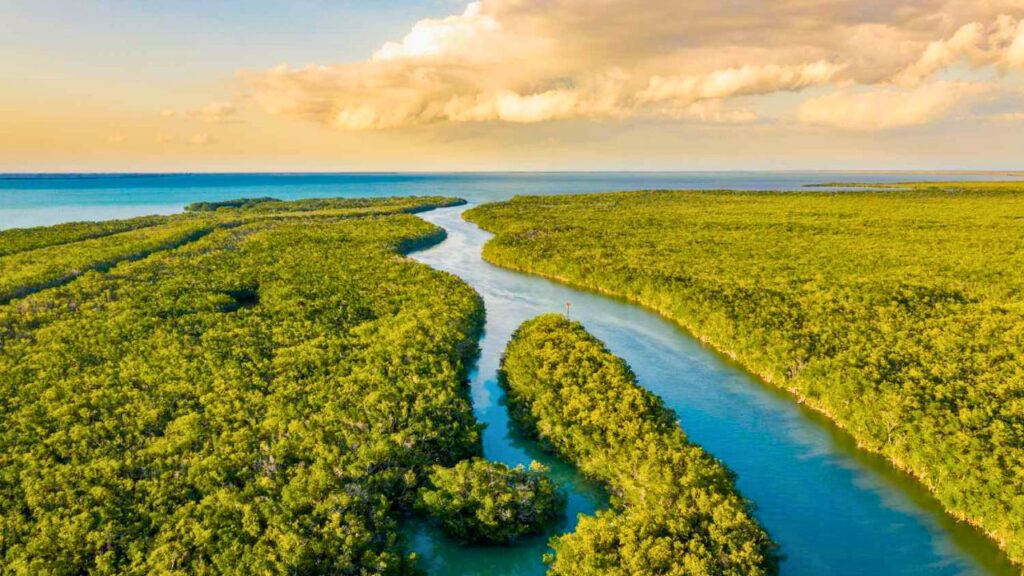
Everglades National Park, a vast and unique ecosystem, is a must-visit for any nature enthusiast. Often referred to as the “River of Grass,” this park protects an unparalleled landscape of subtropical wetlands, sawgrass prairies, mangrove forests, and the estuarine environments of Florida Bay. It’s a haven for an incredible array of wildlife, including alligators, crocodiles, manatees, and a multitude of bird species.
What to See and Do in the Everglades
The Everglades offers a diverse range of activities to immerse yourself in its natural beauty. Here are some highlights:
Shark Valley: Begin your Everglades adventure at Shark Valley, where a 15-mile paved loop road invites you to bike or take a tram tour through the heart of the sawgrass prairie. Keep your eyes peeled for alligators basking in the sun along the waterways – they are abundant here! An observation tower at the halfway point provides panoramic views of this expansive landscape.
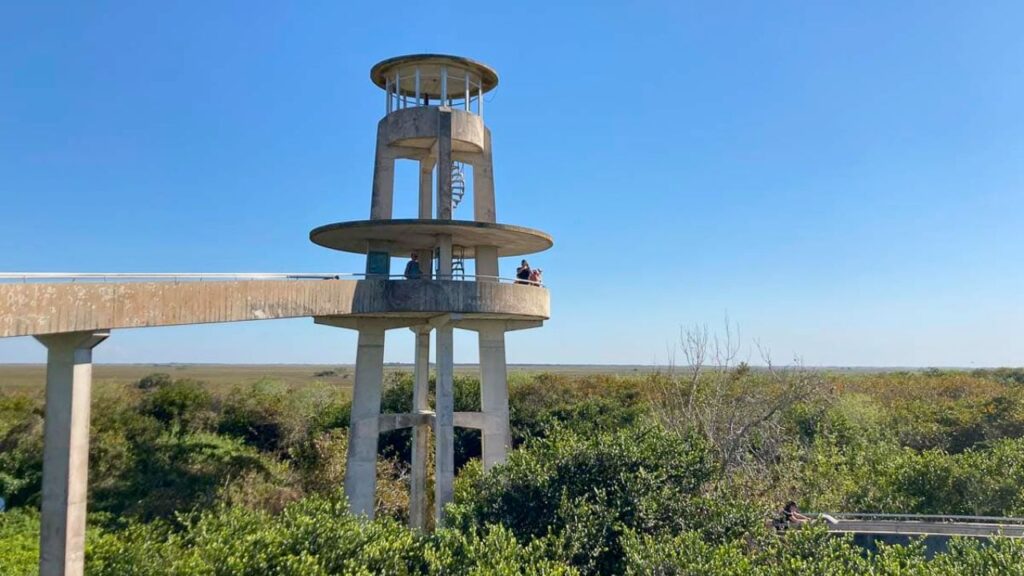
Royal Palm and Flamingo: Explore the southern section of the park, starting at the Royal Palm Visitor Center. Here, you can embark on short, accessible trails like the Anhinga Trail and the Gumbo Limbo Trail, offering excellent opportunities for wildlife viewing, especially various bird species and alligators. Continue south to Flamingo, located on Florida Bay, where you can enjoy boat tours, kayaking, and fishing. This area provides a different perspective on the Everglades ecosystem, showcasing its coastal and marine influences.

Airboat Tours: For a thrilling experience, consider an airboat tour in designated areas outside the main park boundaries. These high-speed rides offer a unique way to glide across the shallow waters and get up close with the Everglades’ iconic wildlife.
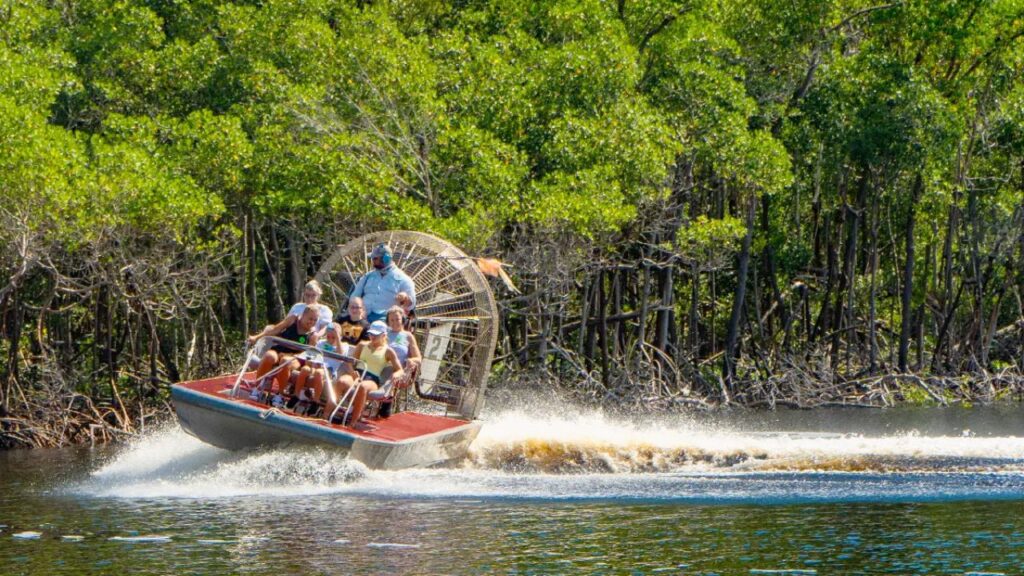
Hiking and Trails: Numerous trails of varying lengths and difficulty levels crisscross the park, allowing you to explore different habitats on foot. From boardwalks through cypress domes to longer hikes through pine rocklands, there’s a trail for every fitness level.
Wildlife Viewing: The Everglades is a birder’s paradise, with a vast array of wading birds, raptors, and migratory species. Keep an eye out for alligators, crocodiles (especially in the brackish waters near Flamingo), turtles, and perhaps even the elusive Florida panther.
Planning Your Visit to Everglades National Park
To make the most of your Everglades experience, consider the following:
- Best Time to Visit: The dry season, from November to May, is generally considered the best time to visit the Everglades. Temperatures are more comfortable, humidity is lower, and there are fewer mosquitoes. Wildlife is also often more concentrated around water sources during this time.
- What to Bring: Pack light, breathable clothing, comfortable walking shoes, a hat, sunglasses, and plenty of sunscreen. Insect repellent is essential, especially during the wet season. Bring binoculars for enhanced wildlife viewing and a reusable water bottle to stay hydrated.
- Where to Stay: Options range from campgrounds within the park to hotels and vacation rentals in nearby towns like Homestead and Everglades City. Booking accommodations in advance is recommended, especially during peak season.
Sample Everglades Itinerary
| Day | Location | Activities |
| Day One | Shark Valley | Bike or tram tour, observation tower visit |
| Day Two | Royal Palm | Anhinga Trail, Gumbo Limbo Trail |
| Flamingo | Boat tour (optional), explore the visitor center, short walks |
Diving into Underwater Wonders: Biscayne National Park
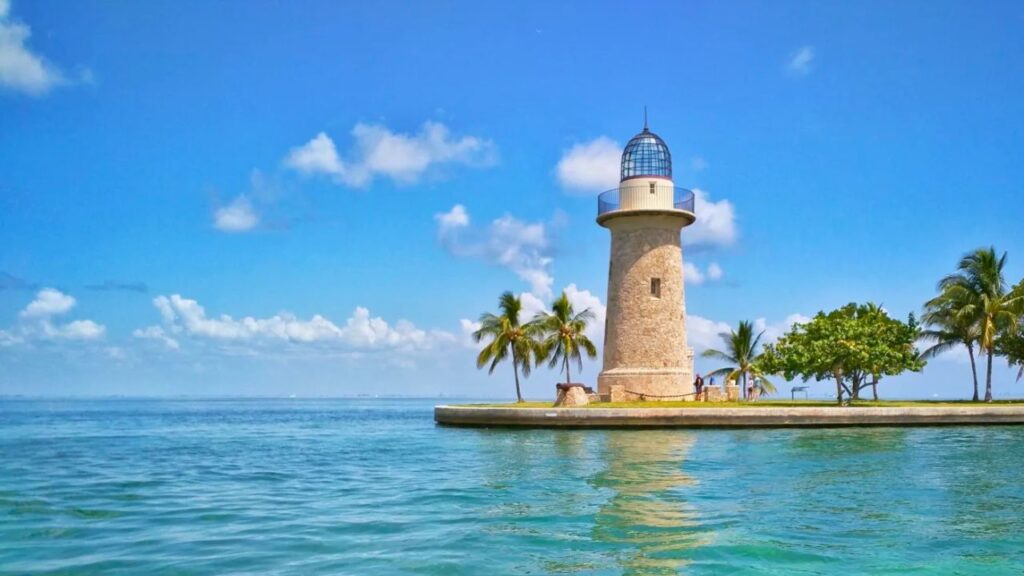
Biscayne National Park offers a unique national park experience, as 95% of it is underwater. Located just south of Miami, this park protects a stunning chain of subtropical islands, mangrove shorelines, and vibrant coral reefs. It’s a paradise for snorkeling, diving, boating, and anyone who appreciates the beauty of marine ecosystems.
Discovering the Treasures of Biscayne National Park
While land-based activities are limited, the true allure of Biscayne lies beneath the surface. Here’s what you can experience:
- Snorkeling and Diving: Explore the colorful coral reefs teeming with marine life. Numerous tour operators offer snorkeling and diving trips to various reef locations within the park. You’ll encounter a kaleidoscope of fish, sea turtles, and other fascinating creatures.
- Boating and Kayaking: Rent a boat or kayak to explore the park’s waters and mangrove-lined islands. Paddle through calm lagoons, discover hidden coves, and enjoy the tranquility of this coastal environment. Several islands, like Elliott Key and Boca Chita Key, offer opportunities for picnicking and hiking.
- Elliott Key: The largest island in the park and the first of the true Florida Keys, Elliott Key offers primitive camping, hiking trails, and a glimpse into the island’s natural vegetation.
- Boca Chita Key: This charming island features a historic lighthouse built in the 1930s, offering panoramic views of the surrounding waters. It’s a popular spot for picnicking and enjoying the coastal scenery.
- Adam’s Key: While access to the island itself is restricted, the waters surrounding Adam’s Key are excellent for wildlife viewing, particularly wading birds.
Planning Your Visit to Biscayne National Park
Here are some tips for planning your Biscayne adventure:
- Best Time to Visit: Similar to the Everglades, the dry season (November to May) offers the most comfortable weather for water activities. The waters are generally clearer during this time, providing better visibility for snorkeling and diving.
- Booking Tours: If you plan on snorkeling or diving, it’s highly recommended to book tours in advance, especially during peak season. Several reputable operators run trips from the mainland.
- What to Bring: Pack swimwear, a towel, sunscreen, a hat, and sunglasses. If you’re planning on spending time on the islands, bring insect repellent as well. If you have your own snorkeling gear, consider bringing it; otherwise, it’s usually provided on tours.
- Park Headquarters: The Dante Fascell Visitor Center on the mainland offers exhibits about the park’s natural and cultural history. It’s a good place to start your visit and learn more about the park before heading out on the water.
Sample Biscayne National Park Itinerary
| Day | Activity | Notes |
| Day One | Morning: Snorkeling or diving tour | Book in advance with a reputable operator. |
| Day One | Afternoon: Boat or kayak rental to explore islands like Elliott or Boca Chita Key | Pack a picnic lunch and enjoy the island scenery. |
Journey to a Remote Paradise: Dry Tortugas National Park
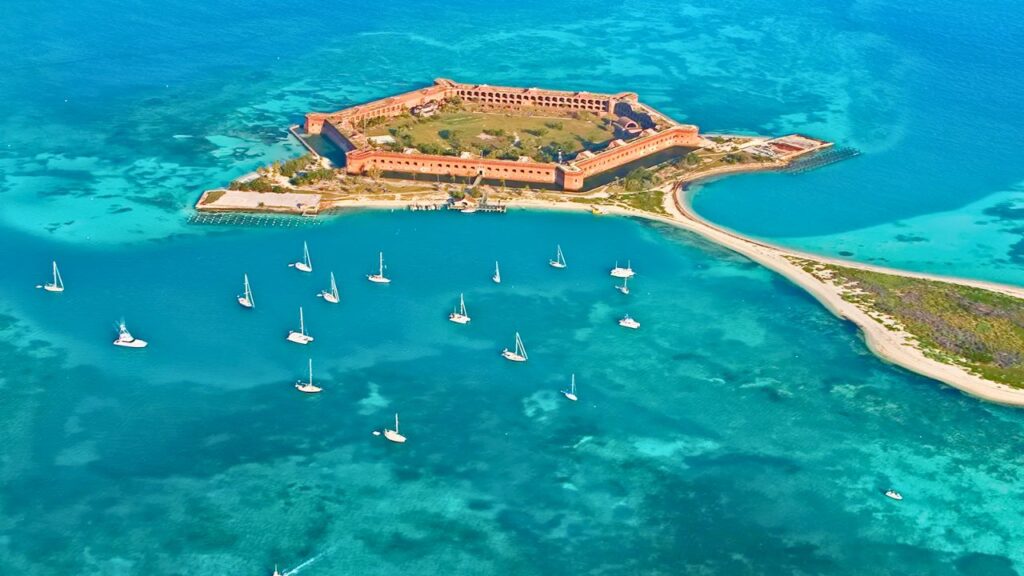
For a truly unique and unforgettable National Park experience, venture to Dry Tortugas National Park. Located about 70 miles west of Key West, this remote cluster of seven islands is accessible only by ferry or seaplane. It’s home to the magnificent Fort Jefferson, stunning coral reefs, abundant birdlife, and fascinating maritime history.
Unveiling the Wonders of Dry Tortugas National Park
The journey to Dry Tortugas is part of the adventure, and the rewards are well worth the effort:
- Fort Jefferson: This massive, unfinished coastal fortress dominates the landscape of Garden Key, the second largest island in the Dry Tortugas. Explore its historic ramparts, learn about its role in Civil War history, and imagine life as a soldier stationed in this isolated outpost.
- Snorkeling and Diving: The waters surrounding the Dry Tortugas boast some of the most pristine coral reefs in the Florida Keys. Snorkel or dive to discover vibrant corals, colorful fish, and perhaps even shipwrecks.
- Birdwatching: The Dry Tortugas are a crucial stopover point for migratory birds, making it a haven for birdwatchers, particularly during the spring and fall migrations. Sooty Terns and Brown Noddy terns nest here in large numbers.
- Camping: For a truly immersive experience, consider camping on Garden Key. Permits are required and space is limited, so book well in advance. Camping under the stars in this remote location is an unforgettable experience.
- Exploring the Islands: While Garden Key is the most visited island due to Fort Jefferson, other islands in the Dry Tortugas offer their own unique charm and opportunities for exploration (some may have restricted access to protect nesting birds).
Planning Your Visit to Dry Tortugas National Park
Visiting Dry Tortugas requires careful planning due to its remote location:
- Transportation: The Yankee Freedom III ferry is the most common way to reach the Dry Tortugas, departing daily from Key West. Seaplane tours also offer a faster but more expensive option. Book your ferry or seaplane tickets well in advance, especially during peak season.
- Day Trip vs. Overnight Stay: You can visit Dry Tortugas as a day trip or opt for an overnight camping experience. Consider your interests and available time when making your decision.
- What to Bring: Pack light but bring essentials like sunscreen, a hat, sunglasses, swimwear, a towel, and any personal snorkeling gear you prefer. Food and drinks are available for purchase on the ferry, or you can bring your own (check ferry regulations). If camping, you’ll need to bring all your own gear, including water.
- Limited Facilities: Be aware that facilities on the Dry Tortugas are limited. There is a small visitor center on Garden Key with restrooms, but other amenities are scarce.
Sample Dry Tortugas National Park Itinerary
| Time | Activity | Notes |
| Morning | Depart from Key West via Yankee Freedom III ferry or seaplane | Ensure you arrive at the departure point well in advance. |
| Late Morning | Arrive at Garden Key, explore Fort Jefferson | Take a self-guided or ranger-led tour of the fort. |
| Midday | Snorkeling or swimming in the waters around Garden Key | Snorkel gear can be rented on the ferry. |
| Afternoon | Continue exploring Fort Jefferson, birdwatching, or relaxing on the beach | |
| Late Afternoon | Depart from Dry Tortugas via ferry or seaplane | |
| Evening | Arrive back in Key West |
Crafting Your Florida National Parks Road Trip
Planning a road trip that incorporates these three distinct National Parks requires some consideration of distances and travel time. A suggested starting point is Miami, which offers the closest major airport. From there, you can easily access Biscayne and Everglades National Parks. The journey to Dry Tortugas involves a trip to Key West, which can be incorporated either before or after visiting the mainland parks.
Here’s a potential framework for a week-long Florida National Parks road trip:
Option 1: Focusing on the Mainland First
- Day 1: Arrive in Miami, pick up your rental car, and explore Biscayne National Park (day trip).
- Day 2-3: Explore Everglades National Park, focusing on different sections like Shark Valley, Royal Palm, and Flamingo. Consider an airboat tour outside the park.
- Day 4: Drive south to Key West. Enjoy the scenic drive along the Overseas Highway.
- Day 5: Day trip to Dry Tortugas National Park via ferry or seaplane.
- Day 6: Explore Key West and its attractions.
- Day 7: Drive back to Miami or fly out from Key West.
Option 2: Starting with the Keys
- Day 1: Arrive in Miami, pick up your rental car, and drive south to Key West.
- Day 2: Day trip to Dry Tortugas National Park.
- Day 3: Explore Key West.
- Day 4: Drive north along the Overseas Highway towards the mainland.
- Day 5-6: Explore Everglades National Park.
- Day 7: Visit Biscayne National Park before departing from Miami.
Important Considerations for Your Road Trip:
- Time of Year: As mentioned earlier, the dry season (November to May) is generally the most pleasant time to visit.
- Reservations: Book accommodations, ferry or seaplane tickets, and tours well in advance, especially if traveling during peak season.
- Flexibility: Be prepared to adjust your itinerary based on weather conditions or unexpected closures.
- Park Passes: Consider purchasing an America the Beautiful Pass if you plan on visiting multiple National Parks within a year.
Conclusion: Embrace the Natural Wonders of Florida
A road trip through Florida’s National Parks offers an incredible opportunity to experience the state’s diverse and captivating natural beauty. From the vast wilderness of the Everglades to the underwater paradise of Biscayne and the remote historical significance of Dry Tortugas, each park offers a unique and unforgettable adventure. By planning your trip thoughtfully and embracing the spirit of exploration, you’re sure to create lasting memories as you discover the must-see National Parks that make Florida a truly special destination.
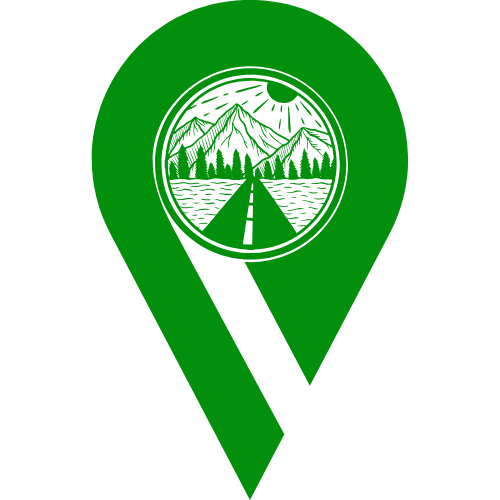
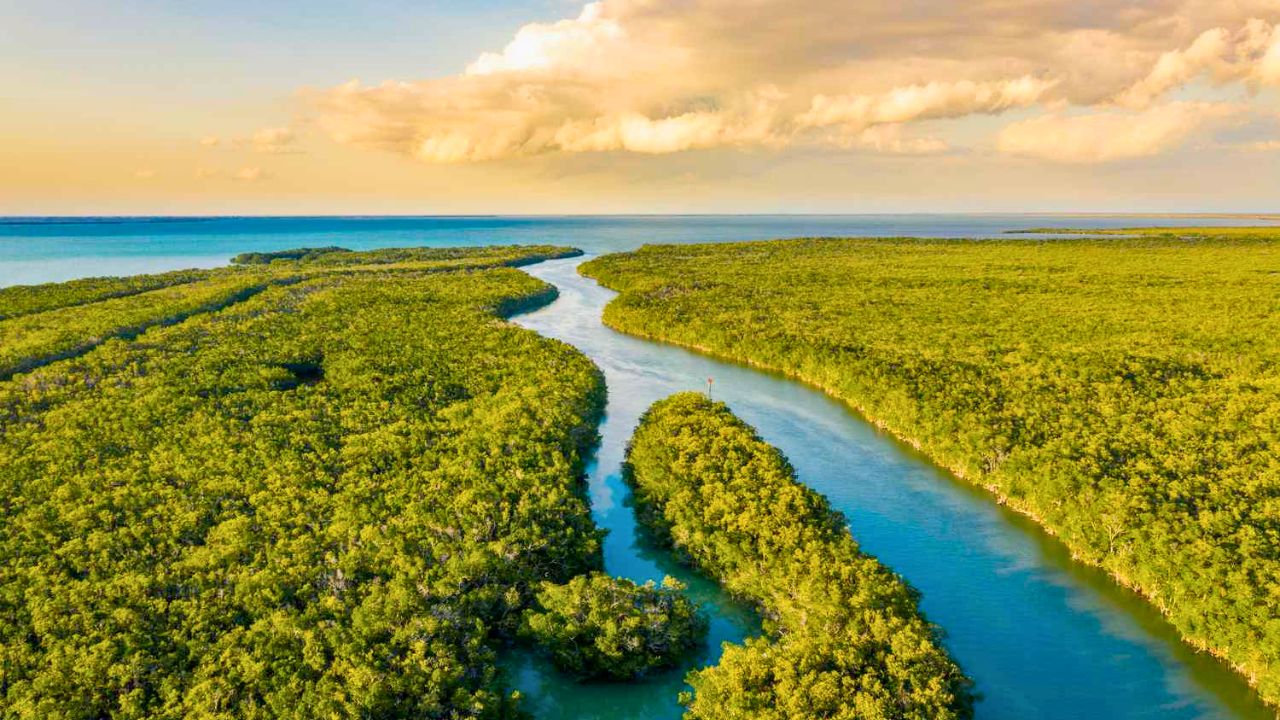
Leave a Reply